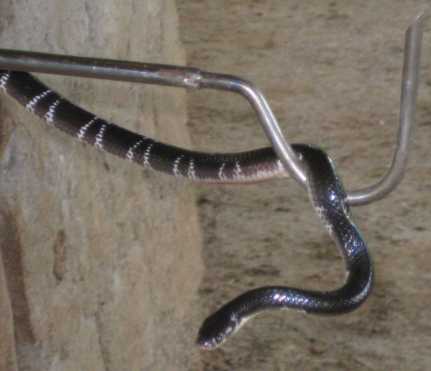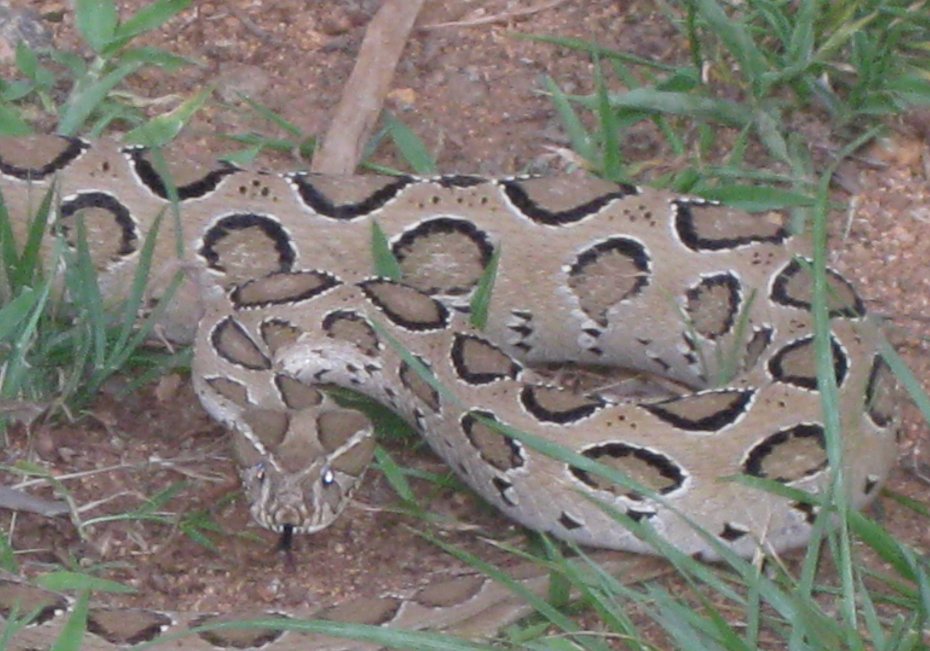Another weekend. Another great trip.
This is a write up about my experience at the snake handling camp that I recently attended at Hunsur. The camp was conducted by the Gerry Martin Project, which is quite famous in India for its research on reptiles, especially crocodiles and snakes. The camp was conducted by Soham from the Madras Croc Bank. We were a small group consisting of Varun, Sharada, Neerav, Asha, Blair, Dinesh, Chaitanya, Soham and myself. We were accompanied by Suresh, a member of the Irula tribe, very experienced in snake tracking and handling. The objective of the camp was to learn more about the behavior of this creature which has always been surrounded by a lot of myth and mystery, learn about the snakes present in India, and a hands-on workshop on handling non-venomous and venomous snakes.
Some of the snakes that we handled during the camp:
Colubrids: This is family of snakes which comprises of most non-venomous snakes like rat-snakes, corn-snakes, wolf-snakes etc. Or, so we thought that these were non-venomous. A recent study has shown that these snakes are in fact as venomous as a cobra or a viper. Its just that the fangs of say, a rat-snake is situated so far behind in its mouth that a normal bite would not be sufficient to inject venom. These are more useful when the snake has got a firm grip on the prey in its mouth, to envenomate the victim . 
- Wolf-snake: A very small snake which can fit into the palm of your hand. Has a flat head and bands starting right from its neck going all the way down to the tip of its tail. It is often mistaken for a common krait, which is highly venomous. But kraits have paired bands which doesn’t start right from the neck. These are expert climbers.
- Rat-snake: A very common snake which has a distinctive zebra-shaped pattern below its mouth. It is usually confused for a cobra because of its size and colour, but it neither has a hood, nor the spectacled mark which the cobra has. Initially it thrashed around when we held it in our hands, but after a bit of gentle handling it calmed down.
 Bronze-back tree snake: This is a hyper-active arboreal snake. It disappeared from sight in a flash when we released him!
Bronze-back tree snake: This is a hyper-active arboreal snake. It disappeared from sight in a flash when we released him!
- Banded racer: Another very active snake, but it is not as quick as the bronze-back. Adults lose their bands.
After this, it was time for some real snakes!
Elapids: It includes venomous snakes like King Cobra, Spectacled Cobra, Monocled Cobra etc, which are mostly oviparous. They have short fangs situated on their upper jaw and these gangs are grooved, through which the venom (neurotoxic) flows. The amount of venom injected is controlled by a muscle and most of the time, when a cobra is trying to defend itself, it does not inject venom because producing venom takes up a LOT of the snake’s energy.
- Spectacled Cobra: This was by far the most awe-inspiring snake that we experienced in the camp
 . This snake is a part of the Big4- 4 medicinally important snakes of India which also includes Russel’s Viper, Saw-scaled Viper and the Common Krait. The Big4 is known to cause the most number of deaths due to snake bites in India and the only cure to their bite is the polyvalent anti-venom, which has anti-bodies for venom of all 4 snakes. The Spectacled Cobra is a short snake. It usually makes a coil from its body and raises a spectacular hood when threatened. It has loads of attitude and looks you right in the eye! And, it strikes with lightening speed at anything which is within striking distance. In other words, it can make you piss your pants. New respect. We were given a long hook to handle the cobra. We had to gently prise away its tail from its body and hold its tail, while using the hook to balance the hood with the other hand, and staying out of reach at all times. This exercise was meant to teach us to remove a cobra to a safe place in c
. This snake is a part of the Big4- 4 medicinally important snakes of India which also includes Russel’s Viper, Saw-scaled Viper and the Common Krait. The Big4 is known to cause the most number of deaths due to snake bites in India and the only cure to their bite is the polyvalent anti-venom, which has anti-bodies for venom of all 4 snakes. The Spectacled Cobra is a short snake. It usually makes a coil from its body and raises a spectacular hood when threatened. It has loads of attitude and looks you right in the eye! And, it strikes with lightening speed at anything which is within striking distance. In other words, it can make you piss your pants. New respect. We were given a long hook to handle the cobra. We had to gently prise away its tail from its body and hold its tail, while using the hook to balance the hood with the other hand, and staying out of reach at all times. This exercise was meant to teach us to remove a cobra to a safe place in c ase we encounter such a situation. We had many attempts at this and by the end we got a hang of how it is to be done, although I am no way confident of handling it alone.
ase we encounter such a situation. We had many attempts at this and by the end we got a hang of how it is to be done, although I am no way confident of handling it alone. - Kraits: These are nocturnal snakes, which are cannibalistic in nature and their venom is highly toxic, possessing neurotoxic (affects the CNS) venom. We had a Common Krait at the camp but we did not handle it, as it was considered too dangerous for us.
Vipers: These are highly venomous snakes with huge fangs which can inject much more venom than a cobra, whose venom is hematoxic (attacks RBC) and cytotoxic (destroys the cells). They have hollow fangs which is filled with venom before striking.
It is divided into Pit Vipers and True Vipers. Pit Vipers have a pit between their nostril and eye on either sides of their head, which help in sensing heat. Malabar Pit Viper is a very common snake of this species, whereas Russel’s Viper is a True Viper. We had a Russel’s Viper at the camp, but it was considered too dangerous to let us handle it simply because they are much more faster than a cobra and you need superior reflexes to be able to handle them.

We learnt how to identify the species of a particular snake. This was done by observing the scalation of the snake, especially on its head, tail, dorsal and ventral sides. Each species has a specific arrangement of scales which is unique to that species. Also we learnt how to ‘sex’ a snake – identifying the gender. We had to insert a steel probe into the cloaca (anal opening) of the snake, depending on how deep the probe travels inside we could decide the sex of the snake. In case of a male, it has well developed hemipenes (reproductory organ) and hence the probe would travel deeper inside, while in case of a female it is underdeveloped and the probe would not travel as deep.
Apart from all this, the camp was also a very nice opportunity to indulge in a bit of ornithology, as it was situated right next to a beautiful lake. I have practically zero knowledge about birds, but spending time with Soham, Chaitanya and Sharada was very educative as they could identify almost every bird which flew in to the lake. It was fun, observing birds through binoculars and comparing them with the ‘Book of Indian Birds’ which we had with us. We also had a drive-through visit to Nagarhole and were pretty lucky to spot a lone Tusker, a mongoose, a wild boar, a lot of malabar squirrels and many more birds.
A few more pictures from the camp can be seen here and here



